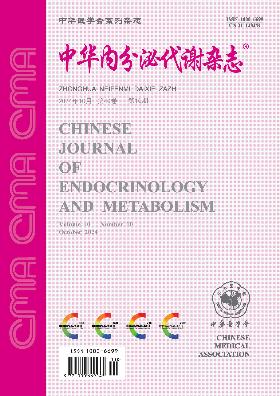糖尿病足骨髓炎病原菌分布特点及药敏分析
Q4 Medicine
引用次数: 0
摘要
目的回顾性分析糖尿病足骨髓炎(DFO)患者病原菌的分布特点及其耐药性。方法收集河南省人民医院内分泌科60例疑似DFO患者。入院后,进行骨活检以确认病理诊断,并通过骨培养测定致病菌和药物敏感性。此外,在伤口的基底组织中进行了细菌培养,并将细菌培养的结果与骨培养的结果进行了比较。结果60例患者经骨活检诊断为DFO。在60例患者中,45例患者接受了骨培养和基底组织培养。结果一致者24例,占53.3%,骨培养阳性率55.0%,革兰氏阳性菌16株,革兰氏阴性菌22株。金黄色葡萄球菌(9株)发生率最高,最常见,其次是大肠杆菌(6株)。骨培养阳性组入院前糖尿病足病程、白蛋白(ALB)和抗生素使用率均低于骨培养阴性组,而白细胞(WBC)和C反应蛋白(CRP)高于骨培养阴性对照组(P<0.05),对万古霉素、替加环素、利奈唑胺等更敏感。大肠杆菌是主要的革兰氏阴性菌,对替加环肽、碳青霉烯类、阿米卡星等更敏感,在应用抗生素之前,应根据操作规范保存和获取骨组织,并根据药物敏感性结果选择合适的抗生素。关键词:糖尿病足骨髓炎;骨活检;骨培养;基础组织培养;病原体;抗生素本文章由计算机程序翻译,如有差异,请以英文原文为准。
Distribution characteristics of pathogen and antibiotic susceptibility in diabetic foot osteomyelitis
Objective
To retrospectively analyze distribution characteristics of pathogenic bacteria and their antimicrobial susceptibility in patients with diabetic foot osteomyelitis(DFO).
Methods
Sixty cases of suspected DFO were collected from the Endocrinology Department of Henan Provincial People′s Hospital. After admission, bone biopsy was carried out to confirm the pathological diagnosis, and the pathogenic bacteria and drug sensitivity were determined by bone culture. In addition, bacterial culture was carried out in the basal tissue of the wound, and the results of bacterial culture were compared with those of bone culture.
Results
Sixty patients were diagnosed as DFO after bone biopsy. Among the 60 patients, 45 patients underwent bone culture and basal tissue culture. There are 24 patients of whom the results were consistent, accounting for 53.3%. The positive rate of bone culture was 55.0%, there were 16 strains of gram-positive bacteria and 22 strains of gram-negative bacteria. Staphylococcus aureus(9 strains) occurrence was the most, common finding, followed by Escherichia coli(6 strains). The course of diabetic foot, albumin(ALB), and antibiotic usage rate before admission were lower in bone culture positive group than those in bone culture negative group, while white blood cell(WBC) and C-reactive protein(CRP) were higher in bone culture negative group(P 0.05). The results of bone culture showed that Staphylococcus aureus was the main Gram-positive bacteria, which was more sensitive to vancomycin, tigecyclin, linezolid, etc. Escherichia coli was the main Gram-negative bacteria, which was more sensitive to tigecyclin, carbapenems, amikacin, etc.
Conclusion
Bone biopsy and bone culture should be carried out in cases for suspected DFO patients to identify the pathogenic bacteria, and the bone tissue should be preserved and obtained according to the operation specification before the application of antibiotics, and the appropriate antibiotics should be selected according to the drug sensitivity results.
Key words:
Diabetic foot osteomyelitis; Bone biopsy; Bone culture; Basal tissue culture; Pathogen; Antibiotics
求助全文
通过发布文献求助,成功后即可免费获取论文全文。
去求助
来源期刊

中华内分泌代谢杂志
Medicine-Endocrinology, Diabetes and Metabolism
CiteScore
0.60
自引率
0.00%
发文量
7243
期刊介绍:
The Chinese Journal of Endocrinology and Metabolism was founded in July 1985. It is a senior academic journal in the field of endocrinology and metabolism sponsored by the Chinese Medical Association. The journal aims to be the "Chinese broadcaster of new knowledge on endocrinology and metabolism worldwide". It reports leading scientific research results and clinical diagnosis and treatment experience in endocrinology and metabolism and related fields, as well as basic theoretical research that has a guiding role in endocrinology and metabolism clinics and is closely integrated with clinics. The journal is a core journal of Chinese science and technology (a statistical source journal of Chinese science and technology papers), and is included in Chinese and foreign statistical source journal databases such as the Chinese Science and Technology Papers and Citation Database, Chemical Abstracts, and Scopus.
 求助内容:
求助内容: 应助结果提醒方式:
应助结果提醒方式:


